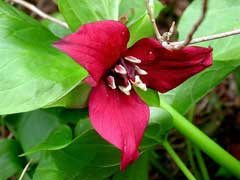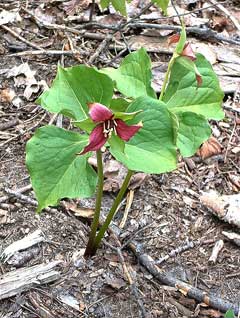 |
|
commons.wikimedia.org/wiki/User:Meneerke_bloem |
 |
|
Translate this page:
Summary
Bloom Color: Purple. Main Bloom Time: Late spring. Form: Upright or erect.
Physical Characteristics

 Trillium erectum is a PERENNIAL growing to 0.4 m (1ft 4in) by 0.3 m (1ft) at a slow rate.
Trillium erectum is a PERENNIAL growing to 0.4 m (1ft 4in) by 0.3 m (1ft) at a slow rate.
See above for USDA hardiness. It is hardy to UK zone 4. It is in flower from May to June. The species is hermaphrodite (has both male and female organs) and is pollinated by Flies.
Suitable for: light (sandy), medium (loamy) and heavy (clay) soils and prefers well-drained soil. Suitable pH: mildly acid, neutral and basic (mildly alkaline) soils. It can grow in full shade (deep woodland) semi-shade (light woodland) or no shade. It prefers moist soil.
UK Hardiness Map
US Hardiness Map
Synonyms
Plant Habitats
Woodland Garden Dappled Shade; Shady Edge; not Deep Shade;
Edible Uses
Edible Parts: Leaves
Edible Uses:
Leaves - raw or cooked. Used in spring[207], the young unfolding leaves are an excellent addition to the salad bowl, tasting somewhat like sunflower seeds[183]. Leaves can also be cooked as a potherb[183].
References More on Edible Uses
Medicinal Uses
Plants For A Future can not take any responsibility for any adverse effects from the use of plants. Always seek advice from a professional before using a plant medicinally.
Antiseptic Aphrodisiac Astringent Birthing aid Expectorant Poultice Tonic Urinary
Uterine tonic
Beth root was traditionally used by various native North American Indian tribes as a woman's herb to aid childbirth, as a treatment for irregular menstrual periods, period pains and excessive vaginal discharge[254]. Modern research has shown that the root contains steroidal saponins, which have hormonal effects on the body[222, 238]. These saponins are being used in gynaecological and obstetric medicine[238]. This herb should not be taken during pregnancy except under professional supervision[254]. The root is antiseptic, aphrodisiac, astringent, expectorant, tonic, uterine tonic[4, 46, 61, 165, 222, 238]. It is used internally in the treatment of a wide range of women's complaints including haemorrhage from the uterus, urinary tract and lungs, and also to curb excessive menstruation[238]. It has proved to be of value in stopping bleeding after parturition[244]. Externally, it is used to treat excessive vaginal discharge, ulcers (especially varicose), skin complaints, gangrene, insect bites and stings[238, 244]. It is also used as a wash for sore nipples[244]. The root is harvested in late summer, after the leaves have died down, and is dried for later use[213, 238]. The whole plant is used as a poultice for tumours, inflammations and ulcers[222].
References More on Medicinal Uses
The Bookshop: Edible Plant Books
Our Latest books on Perennial Plants For Food Forests and Permaculture Gardens in paperback or digital formats.

Edible Tropical Plants
Food Forest Plants for Hotter Conditions: 250+ Plants For Tropical Food Forests & Permaculture Gardens.
More

Edible Temperate Plants
Plants for Your Food Forest: 500 Plants for Temperate Food Forests & Permaculture Gardens.
More

More Books
PFAF have eight books available in paperback and digital formats. Browse the shop for more information.
Shop Now
Other Uses
References More on Other Uses
Cultivation details
Landscape Uses:Border, Ground cover, Woodland garden. Prefers a deep well-drained woodland or humus-rich soil in a somewhat shady position that remains moist in the summer[1, 42]. Prefers a neutral to slightly acid soil[200]. Grows well in open deciduous woodland[1, 90]. Succeeds in a sunny position if the soil does not dry out[42]. Succeeds in deep shade[188]. A very hardy plant, tolerating temperatures down to about -35°c[238]. Plants are long-lived[233]. Any transplanting is best done whilst the plants are in flower[200]. A very variable species[200], it is subject to mutation[90]. Members of this genus are rarely if ever troubled by browsing deer or rabbits[233], though slugs are very fond of the leaves[238]. The flowers have an unattractive smell rather like putrefied flesh[42, 207, 245]. The white-flowered form, blandum, is almost scentless[245]. Plants can flower in two years from seed[138]. Special Features:Attractive foliage, North American native, Naturalizing, Flowers have an unpleasant odor.
References Carbon Farming Information and Carbon Sequestration Information
Temperature Converter
Type a value in the Celsius field to convert the value to Fahrenheit:
Fahrenheit:
The PFAF Bookshop
Plants For A Future have a number of books available in paperback and digital form. Book titles include Edible Plants, Edible Perennials, Edible Trees,Edible Shrubs, Woodland Gardening, and Temperate Food Forest Plants. Our new book is Food Forest Plants For Hotter Conditions (Tropical and Sub-Tropical).
Shop Now
Plant Propagation
Seed - best sown in a shaded cold frame as soon as it is ripe[134, 200]. Stored seed should be sown in late winter or early spring. Seed usually germinates within 1 - 3 months at 15°c. Another report says that seeds produce a root after the first cold stratification but no shoot is produced until after a second winter[138], whilst yet another report says that the seed can take 3 years to germinate[238]. The seedlings are prone to damp off and must therefore be watered with care and given plenty of fresh air[138]. The young plants need to be overwintered in a cold frame for the first year and can then be planted out in late spring. It is very important that the pots become neither too dry nor too wet[138]. Division with care when the plants die down after flowering[200]. Larger divisions can be planted out direct into their permanent positions. We have found that it is best to pot up smaller divisions and grow them on in light shade in a greenhouse or cold frame until they are growing away well. Plant them out in the following spring.
Other Names
If available other names are mentioned here
Native Range
NORTHERN AMERICA: Canada (Québec, Nova Scotia, Ontario, Manitoba), United States (Indiana, Maine, Massachusetts, Michigan, New Hampshire, New Jersey, New York, Ohio, Pennsylvania, Rhode Island, Connecticut, Illinois, Delaware, Georgia (north), Kentucky, Maryland, North Carolina, South Carolina, Tennessee)
Weed Potential
Right plant wrong place. We are currently updating this section.
Please note that a plant may be invasive in one area but may not in your area so it’s worth checking.
Conservation Status
IUCN Red List of Threatened Plants Status :

Growth: S = slow M = medium F = fast. Soil: L = light (sandy) M = medium H = heavy (clay). pH: A = acid N = neutral B = basic (alkaline). Shade: F = full shade S = semi-shade N = no shade. Moisture: D = dry M = Moist We = wet Wa = water.
Expert comment
Author
L.
Botanical References
43200270
Links / References
For a list of references used on this page please go here
Readers comment
© 2010, Plants For A Future. Plants For A Future is a charitable company limited by guarantee, registered in England and Wales. Charity No. 1057719, Company No. 3204567.